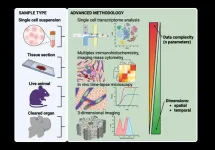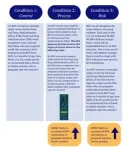Spatial dimension of macrophage heterogeneity in liver diseases
2023-08-08
(Press-News.org)
This review manuscript highlights the relevance of spatially-resolved macrophage phenotyping in liver disease-related research.
The liver is a vital organ heavily populated with macrophages, which represent key players of the innate immune response but also hold key functions in the maintenance of a healthy organ. Liver macrophages are mostly distributed across two populations of different origins and functions during homeostasis and disease: liver resident macrophages (referred to as Kupffer cells, KCs), and monocytic macrophages derived from the bone-marrow (MoMFs). The KC: MoMF ratio, as well as their respective spatial distribution through the liver, are increasingly recognized as liver disease progression hallmarks. These phenomena are observed in a wide variety of liver diseases ranging from non-alcoholic fatty liver disease to biliary tree disorders (cholangiopathies).
Recent single cell analyses revealed previously underestimated heterogeneities within those two major populations. These studies were rendered possible by recent technological breakthroughs in transcriptomics, proteomics and bioinformatics, particularly in single cell RNA sequencing and multiplex immunostaining. Nowadays, the map of the liver macrophage landscape is being refined to include this phenotypical and functional heterogeneity, in a 2- and 3-dimensional resolved manner.
The most striking changes occurring at later stages of liver disease include a depletion in KCs and an accumulation of MoMFs with a strong pro-inflammatory phenotype and poor phagocytosis capacities in perilobular fibrotic areas, while lipid-associated macrophages are observed in steatotic areas during fatty liver disease.
About the eGastroenterology
eGastroenterology is a new, open-access, and open peer-reviewed BMJ Journal, which focuses on basic, clinical, translational, and evidence-based medicine research in all areas of gastroenterology (including hepatology, pancreatology, esophagology, and gastrointestinal surgery).
For more information, please visit: egastroenterology.bmj.com and follow us on Twitter (@eGastro_BMJ).
END
[Attachments] See images for this press release:


ELSE PRESS RELEASES FROM THIS DATE:
2023-08-08
A study looks at the mechanisms behind genetic variation in the bacteria that cause Lyme disease. Lyme disease is the most common vector-transmitted disease in the United States, with around 476,000 human cases annually. Most Lyme disease is caused by the bacteria Borrelia burgdorferi (Bb), which is transmitted by ticks and can infect a wide range of mammals and birds. Matthew Combs and colleagues analyzed the genetic diversity of Bb, specifically focusing on the pathogen’s outer surface protein C (ospC) gene, a well-known virulence factor that is essential for survival of the pathogen inside the tick and the early stages of infection in vertebrates. ...
2023-08-08
***Embargo 14:00 UK / 10:00 BRT / 9:00 ET / 6:00 PT Tuesday, August 8, 2023***
SEATTLE, Wash. August 8, 2023 – 569,000 deaths were linked to bacterial antimicrobial resistance (AMR) in all 35 countries of the WHO Region of the Americas, according to a new peer-reviewed paper published in The Lancet Regional Health – Americas. This analysis on the burden of AMR in the Americas is the most comprehensive yet for the region, providing data for 35 countries, 23 bacterial pathogens, and 88 pathogen-drug combinations.
The ...
2023-08-08
Humans are social creatures and learn from each other, even from a young age. Infants keenly observe their parents, siblings or caregivers. They watch, imitate and replay what they see to learn skills and behaviors.
The way babies learn and explore their surroundings inspired researchers at Carnegie Mellon University and Meta to develop a new way to teach robots how to simultaneously learn multiple skills and leverage them to tackle unseen, everyday tasks. The researchers set out to develop a robotic AI agent with manipulation abilities equivalent to a 3-year-old child.
The team has announced RoboAgent, an artificial intelligence agent that leverages passive observations and active ...
2023-08-08
Every year in the United States, about 1.7 million youth run away from home, which places them at risk for sex trafficking and prostitution. Sadly, most youth tend to fall victim to sex trafficking between the ages of 12 to 14.
While federal and state laws have been enacted to protect these runaway youth, they continue to be arrested, charged and detained for prostitution. Detaining youth who should not legally be considered offenders and who have extensive histories of victimization and mental health issues only exacerbates their underlying vulnerabilities that may have led them to run away or be sexually exploited in the first place.
There is ...
2023-08-08
Insilico Medicine (“Insilico”), a clinical stage generative artificial intelligence (AI) drug discovery company, has announced that it is now a member of the Chamber of Commerce of Metropolitan Montreal, demonstrating its commitment to the vibrant business community of Montreal and to fostering economic growth in the region. Insilico will officially launch its AI R&D Center in Montreal later this fall.
As a new member of the Chamber of Commerce of Metropolitan Montreal, Insilico brings its innovative expertise ...
2023-08-08
NEW YORK, August 8, 2023 — CUNY ASRC researcher Adam Braunschweig’s lab is part of a newly awarded $20 million center from the U.S. National Science Foundation to understand the atomic-scale mysteries of "crushing" chemistry. The multi-institutional award will establish the Center for the Mechanical Control of Chemistry (CMCC), which will conduct work to understand how the mechanical application of force can enable new advances in chemistry and make industrial processes cheaper and more environmentally friendly.
“I’m excited that my lab is playing a part in research ...
2023-08-08
Sociality plays a pivotal role in the lives of many animal species, influencing mating success, survival rates, and susceptibility to diseases. In the challenging environment of bighorn sheep populations, sociality is believed to have evolved for its fitness benefits. However, the delicate balance of costs and benefits associated with sociality can vary at different scales, leading to diverse interpretations of animal behavior.
New research titled "Bighorn sheep associations: understanding tradeoffs of sociality and implications for disease transmission" has been published in PeerJ Life & Environment. The study, ...
2023-08-08
An article in CMAJ (Canadian Medical Association Journal) highlights a case of lead toxicity from Ayurvedic medicines in a young woman, and the complexity in diagnosing the rare condition https://www.cmaj.ca/lookup/doi/10.1503/cmaj.230592.
"Given that lead toxicity is uncommon and its presentation nonspecific, patients are often seen by many health care providers before the diagnosis is made," writes Dr. Julian Gitelman, Dalla Lana School of Public Health, University of Toronto, with coauthors. "A careful exposure history is essential to suggest the diagnosis."
The patient, a 39-year-old woman, visited the emergency department 3 times in 6 weeks ...
2023-08-08
Skin, the largest organ of the human body, is home to a vast array of bacteria, fungi, and viruses – microorganisms that compose the skin microbiota. Among other things, these microbial populations, which are organized in complex community structures, protect against pathogens.
Prolonged exposure to UVR is associated with damage to DNA in skin cells, inflammation, and premature skin aging, yet intentional sun-seeking behaviors remain common.
Due to a lack of studies focusing on how individual behavior influences UVR-associated microbiota shifts, and how this may relate to skin health, ...
2023-08-08
Extreme events in Antarctica such as ocean heatwaves and ice loss will almost certainly become more common and more severe, researchers say.
With drastic action now needed to limit global warming to the Paris Agreement target of 1.5°C, the scientists warn that recent extremes in Antarctica may be the tip of the iceberg.
The study reviews evidence of extreme events in Antarctica and the Southern Ocean, including weather, sea ice, ocean temperatures, glacier and ice shelf systems, and biodiversity on land and sea.
It concludes that Antarctica’s fragile environments “may well be subject to considerable stress and ...
LAST 30 PRESS RELEASES:
[Press-News.org] Spatial dimension of macrophage heterogeneity in liver diseases







